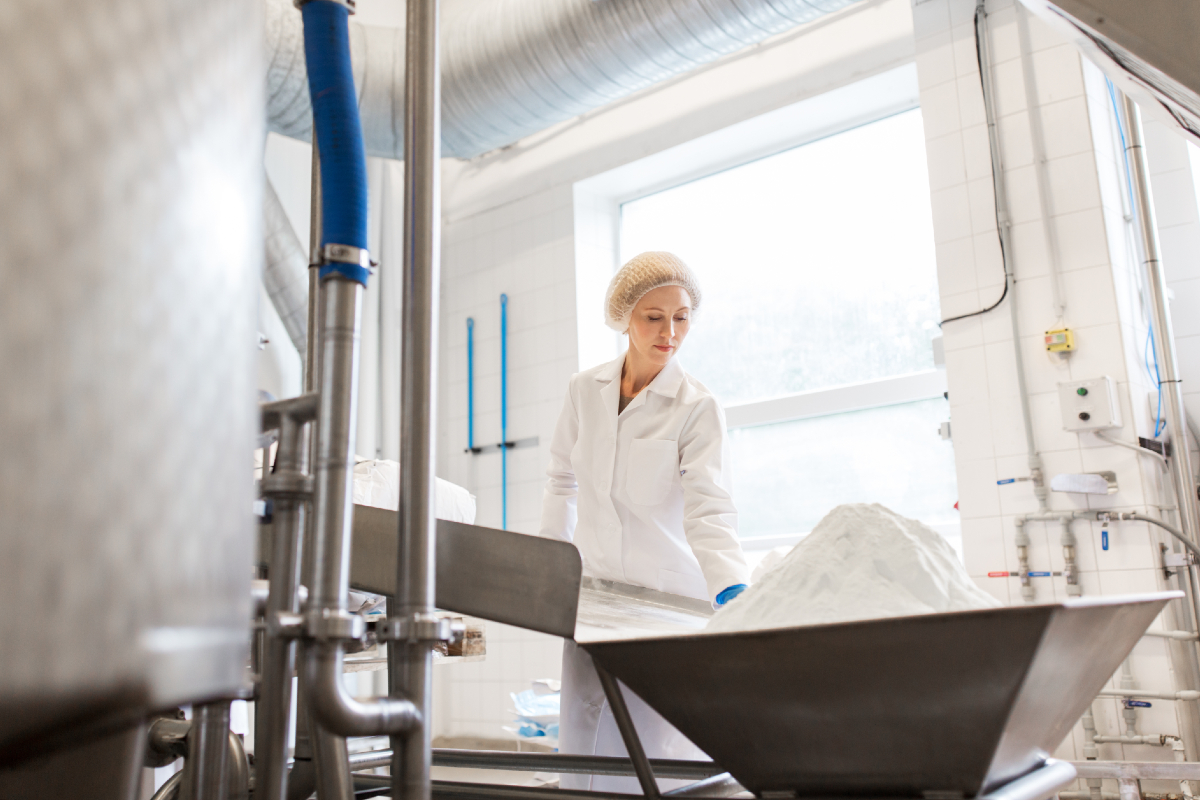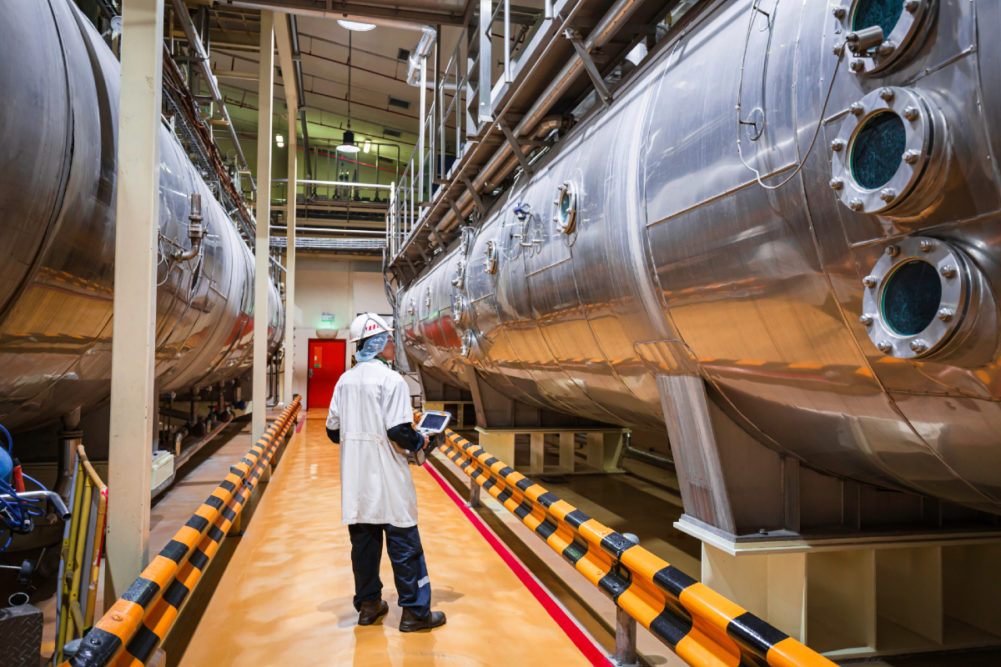Within the dairy processing industry, ultra-specific guidance exists for cleaning a facility’s wet environments, and another set of specified procedures are associated with dry environments. However, the benefits of dry cleaning practices are appealing enough to make some processors utilize them in traditionally wet cleaning areas, as well, when that’s possible.
The experts at clean in place (CIP) solutions innovator Ecolab, St. Paul, Minn., will tell you that operations are inherently different, and some may need to implement water-based cleaning instead of dry cleaning. Even so, the company’s executives area technical support coordinator, Jesse Hines, noted interest for dry cleaning is growing.
“There are still areas that are regularly using wet-cleaning methods where we’re seeing people shift their attention to dry cleaning,” Hines said, giving the large dryers used by formula manufacturers as a chief example.
Associated advantages
Taking a dry sanitation approach to cleaning equipment in a dairy processing facility comes with hygienic advantages. First of all, Hines pointed out, that approach helps limit the presence of such microorganisms as salmonella and cronobacter sakazakii by “starving them” of the water they need to grow.
“While most dry cleaning products shouldn’t be relied on to singlehandedly kill off these organisms, dry cleaning is an integral part of an improved cleaning and sanitization practice that extends processing times while meeting core hygiene standards,” Hines explained.
Certain dairy products benefit most from avoiding water use while cleaning equipment, he said, identifying powders in particular, such as those used in the production of skim milk powders, whole milk whey proteins and infant formula.
Patrick Casey, a regional sales manager for food safety chemical manufacturer Best Sanitizers, Inc., Penn Valley, Calif., said multiple areas within a given dairy facility may be sensitive to water, offering cooler and freezer areas and the processing equipment itself (depending on what is being produced) as examples.
“The primary hygienic advantage of utilizing dry cleaning practices on dairy processing equipment is that you are not adding or leaving behind any water which has the potential to breed bacteria and contaminate and/or damage the taste, color or quality of the finished product,” Casey said.
He also raised the point that facility employees may learn to appreciate a different approach to sanitation.
“Rather than removing unwanted material from the processing environment, high water pressure can have the unintended result of simply pushing soil, debris and bacteria to other parts of the equipment or facility,” Casey said. “While using water with high pressure sprayers might seem like an easy solution to remove extra soil loads, the easy solution could create further complications down the road.”
The pathogen control guidance document published by the Innovation Center for US Dairy, Rosemont, Ill., notes that listeria species and salmonella can survive for prolonged periods, but don’t grow in dry – or low water activity – environments. In dry dairy production areas, the Innovation Center also points to a key rule: “dry needs to stay dry.”
Tim Stubbs, senior vice president and food safety lead for the Innovation Center, said one of his favorite analogies is “when it rains in the desert, you see plants and flowers explode; the same thing happens in a dry plant with microorganisms” when water is introduced.
An added bonus that comes with dry cleaning processes, Ecolab tells its customers, is tied to sustainability and environmental goals. When making use of water-based cleaning techniques, a dairy processor typically must use hot water that gets heated through a boiler – and moving, heating and treating that water requires the plant to expend energy.
Sustainability is also an area of consideration for operators. Ecolab’s experts stated that by leveraging dry cleaning instead of water, dairy processors can potentially reduce energy consumption, greenhouse gas emissions and water consumption, issues which plague the industry.
Ecolab recommends that dairy processors work with suppliers who can help assess the needs of an entire facility comprehensively to determine what type of cleaning and treatment programs work best.
“Dry cleaning processes are already very common in certain areas of dairy processing facilities, especially those that dry and blend powders, like infant formula manufacturers,” Hines added.
 Photo: Syda Productions - stock.adobe.com
Photo: Syda Productions - stock.adobe.comOptimal procedures
Casey expressed that “any dairy product” would benefit from avoiding the use of water during the equipment cleaning process, while the production of powdered milk, coffee creamer, cheese whey, ice cream and instant breakfast mix were among the first to come to mind.
He noted that best practices associated with dry cleaning in a facility include “high quality cleaning products, appropriate dry time of the equipment, proper PPE (personal protective equipment) and ensuring a safe work environment while performing the cleaning.”
And as Hines said, “There are no shortcuts when it comes to creating an effective dry cleaning program in a dairy plant.”
Best practices have to start at the top of a business, Hines added, with a strong food safety culture, high levels of technical expertise and the right tools to properly execute the program.
“Furthermore, effective rollout requires sanitary design, knowledge of zoning limitations and effective controls over air flow and humidity,” he said. “Properly executed risk assessments and master sanitation schedules are key, as well.”
Per the Innovation Center’s guidelines, normal daily cleaning of dry clean areas includes bagging, packing and sifter rooms, storage bins areas, and anything post dryer and the dryer tower. Recommended cleaning while taking a top-down approach involves distinct types of dry towels, brushes and vacuums to collect and remove all product from the environment.
The center’s document also mentions that facilities in which dry dairy products and powders are produced frequently have some wet processing, too. Therefore, maintaining a “high level of hygiene” in wet areas is crucial, as is a “clear separation” that keeps moisture out of the dry areas.
“Traffic from wet to dry should be controlled with transition areas that have some form of dry floor mitigation,” the pathogen control guide states.
Within the Innovation Center’s expansive guidance document for US dairy processors, it offers tips specific to dry sanitation. One reminder focuses on the cleaning tools and the need to ensure they don’t become a source of contamination. Brushes, brooms, dust pans, vacuums and the like should be part of the overall sanitation and environment monitoring plans.
The center also recommended fast drying alcohol sanitizer for certain products that don’t have sensitivity to quaternary ammonia. It also endorsed chlorine dioxide gas for sanitizing difficult to reach dry equipment, while also underlining that trained personnel and proper safety is crucial when cleaning with that chemical compound.
Inherent obstacles
Not unexpectedly, moving away from wet cleaning practices can come with some challenges.
“In general, legacy equipment was designed to be cleaned with wet chemical solutions, which creates a few stumbling blocks in the transition to dry cleaning,” Hines said. “Dry cleaning generally requires a more hands-on approach compared to liquid CIP solutions. For example, maintenance may require manual scrubbing, as opposed to the automated spraying or flowing associated with liquid CIP solutions.”
The atmospheric moisture within a designated space, he added, introduces another set of potential problems to consider.
“Controlling humidity and maintaining a dry environment can also pose challenges since common facility items like work boots, wheels and pallets can unintentionally create microorganism concerns by tracking water into places it shouldn’t be,” Hines explained.
Additionally, while it is possible to design a validated dry cleaning program to manage allergens, he said doing so is more difficult than making programs with liquid-based sanitation practices.
The Innovation Center noted that the evaporation of any liquids – and especially those containing water – may result in the relative humidity changing in a room, depending on a facility’s air handling efficiency. And a change in relative humidity could lead to the formation of condensation at another point in the system.
The center offers a seven-step manual for cleaning and sanitation in a dry environment. It involves pre-sanitation preparation; securing, dismantling and inspecting equipment; pre-cleaning; detail cleaning; final cleaning; sanitation inspections; and final inspection and documentation.
Along with the necessary details tied to each step in the process, the center’s guidance gives examples of results that point to poor sanitation and sources of contamination. Those include water in dry areas, high pressure air, reusable cleaning tools, system breeches, undetected water leaks, product buildup and unbalanced air flow.

